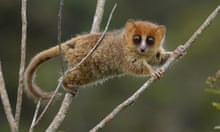With its big eyes, bushy tail and sensitive ears, the aye-aye may appear a cute, if quirky, creature. But now researchers have discovered it has a less endearing trait: it uses its long middle finger to pick its nose – and eat the mucus.
Aye-ayes are – like humans – primates, but they are nocturnal, endangered and only found in Madagascar. An object of superstition, they have a number of unusual features, including rodent-like teeth and a skinny, elongated finger with a ball-and-socket joint.
While it is known the animal uses its phenomenal finger for tapping on hollow wood to locate grubs and fish them out, researchers have revealed they have video footage of it being used for another, rather mundane, purpose: nose picking.
“While doing so, this animal inserts the entire length of its extra-long, skinny and highly mobile middle finger into the nasal passages and then licks the nasal mucus collected,” the authors wrote in the journal of Zoology.
Dr Anne-Claire Fabre, an assistant professor at the University of Berne and a scientific associate of London’s Natural History Museum who co-authored the research, said she recorded the behaviour on video in 2015 while observing captive aye-ayes at the Duke lemur centre.
“I was really surprised,” Fabre said, adding the whole middle finger disappeared up the creature’s nose. “It is nearly 8cm – it is really long, and I was wondering where this finger is going.”
To dig deeper, the researchers created a 3D model using CT scans of the head and hand of the aye-aye to understand where the middle finger was going. The findings suggested the digit extended deep into the head.
“This finger is basically ending in the throat,” said Fabre, adding that while nose-picking had not been observed in aye-ayes in the wild, that did not mean it did not occur.
The team said the aye-aye was in good company when it came to nose-picking, revealing the trait had been recorded in at least 11 other primate species including humans, capuchins, macaques, chimpanzees and orangutans, with some species also using tools to do the job. The researchers said nose-picking appeared to be most common in species with fine manipulative skills.
It is not clear why aye-ayes, or other species, have a penchant for nose-picking, with the researchers noting it could just be an act of “self-cleaning”. But, they added, the fact several species ate the mucus suggested there may be other explanations.
after newsletter promotion
Among them, the team noted, were studies that suggested the “texture, crunchiness, and saltiness” of the matter could be appealing, that snot-eating may prevent bacteria from sticking to teeth and that the trait could boost immune responses. However, there could be a downside, they said: other research has suggested nose-picking spreads nasal bacteria.
Fabre added that nose-picking was understudied and more research was needed. “You never know when studying this type of behaviour where you can end up, and sometimes you can discover an application that we’re not expecting,” she said.








